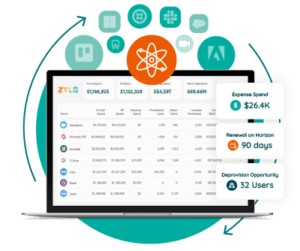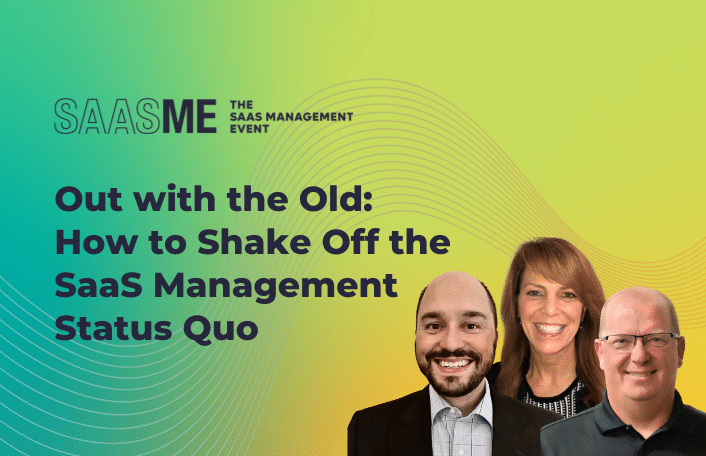Table of Contents
One truth remains constant: change is inevitable. Yet, amidst myriad shifts and advancements, businesses often overlook a fundamental challenge – the effective management of Software as a Service (SaaS). In modern enterprises, ignoring the criticality of SaaS Management can have long-lasting repercussions. It’s no longer a question of preference but a necessity for sustainable growth and resilience.
Drawing insights from our recent SaaSMe conference session, we bring you a conversation featuring three distinct voices from IT, finance, and technology asset management.
- Gordon Atkin, VP, Technology & Business Platforms at Salsify
- Renee Turco, Sr. Manager, Asset Management at AbbVie
- Russell Lester, 3X SaaS CFO
Join us as we unravel the complexities, challenges, and opportunities surrounding SaaS Management and discover why it’s a conversation businesses can’t afford to ignore any longer.
Enterprises today need to employ effective SaaS Management. Overlooking this essential component of digital infrastructure can have repercussions beyond the IT department, impacting finances, security, and overall productivity.
Identifying the Status Quo & Challenges
Q: How did you identify the need for a change in your SaaS Management approach, and what triggered the demand to change the status quo?
 Gordon Atkin: Doing an inventory of all of our SaaS applications was my trigger point. The first time I became a Zylo customer, we did our own inventory, where we came up with about 150 applications. And then we engaged with Zylo. One of the things you guys came to the table with was that we had well over 300 applications through your discovery and inventory side. Once I had visibility into the real SaaS inventory, I realized we’ve got to do something differently because we obviously can’t identify our apps. If we only found 150 applications and Zylo’s identifying another 150, something’s wrong, and we’ve got to change how we manage our SaaS. That was the precipice for us in my first experience and the other two I had. Doing that inventory exercise makes it easy to demonstrate why you need to change the status quo.
Gordon Atkin: Doing an inventory of all of our SaaS applications was my trigger point. The first time I became a Zylo customer, we did our own inventory, where we came up with about 150 applications. And then we engaged with Zylo. One of the things you guys came to the table with was that we had well over 300 applications through your discovery and inventory side. Once I had visibility into the real SaaS inventory, I realized we’ve got to do something differently because we obviously can’t identify our apps. If we only found 150 applications and Zylo’s identifying another 150, something’s wrong, and we’ve got to change how we manage our SaaS. That was the precipice for us in my first experience and the other two I had. Doing that inventory exercise makes it easy to demonstrate why you need to change the status quo.
Q: How were you handling SaaS Management? Spreadsheets and duct tape? Ignorant bliss? How effective was that? How did you identify that a change in approach was critical?
Renee Turco: We were on the infamous spreadsheet for more than a thousand annual renewals, with almost 1,600 applications in the environment. We are a very large company, and at the time, we were looking at SaaS Management tools while doubling in size. We didn’t have a handle on our SaaS-based software, and missed renewals occurred. We had inconsistencies in reporting and had no idea what our shadow IT was from an expense perspective, because we didn’t have insights into corporate credit card spend on software. And even for items we did see, if someone were to code it incorrectly through the purchase order, we wouldn’t see it.
Those are some key aspects that Zylo has brought to the table for us through the Zybrary. Even if somebody codes something incorrectly from a spending perspective, we still have visibility into that, which we didn’t have before. We knew that our SaaS portfolio was growing tremendously and had no visibility. So, from an asset management perspective, we couldn’t optimize that spend with further contract consolidation with our procurement and vendor management teams. From an audit perspective, our team is responsible for all third-party publisher audits. If you don’t have insight into what you’re spending and what you’re consuming, there are a lot of gaps. Put that all together, and we knew we needed a SaaS Management platform.
Strategies for Breaking Free & Leading Change
Q: When you were ready to invest more heavily in SaaS Management, how did you get other leaders in your organization on board?
Russell Lester: It begins with helping people understand the opportunity. There’s also the finance function — maximizing runway, unlocking liquidity, and ensuring you achieve the proper ROI on investments. A lot of people don’t think of SaaS spend in that way. Many people also don’t realize how much waste there is and how much additional liquidity you can unlock if you reduce that waste. A high-level opportunity sizing is one of the critical components, but finding one stakeholder to be the co-sponsor with you is also critical.
In my case, the IT organization was that partner who agreed that we wanted to solve this together. We went in as a unified force. And for us, it all rolled into the finance organization, so we had it all working in concert together. Lastly is the center of table concept — the dollars we free up through SaaS Management go to the center of the table. Then, the executive team can ask what we need to do to redeploy those unlocked funds. So it’s not that finance and IT get to sit on those unlocked funds; it’s all ours. It’s redeployed to the center of the table and back to the company to spend in the best way possible to maximize ROI.
Why Now?
Q: If your fellow CIOs and IT / Procurement / SAM leaders asked you, “Why now?” what would you tell them?
Russell Lester: SaaS Management is the right thing to do for any stage of business, and I had a good opportunity to be part of three different use cases. The first use case was a mature, high-growth SaaS business with years of tech debt and various technology solutions that had been attempted with different leadership changes cycling through. So, in that use case, there was a layering effect of technology, some of which people had forgotten existed.
The second use case was a very high product-led growth company diversifying into sales-led growth. So, we were setting up multiple back office systems simultaneously at a hypergrowth pace, which means we were selecting some of the right tools and, in some cases, not the right tools. It was an opportunity to look at the full landscape in a way that hypergrowth sometimes doesn’t allow.
In the third use case, five legacy companies came together under one brand. Again, you have overlapping technologies doing the same thing but without a clear ability to see that without a platform like this. And it’s not just the platform; it’s the mindset, the people, and the processes you put in place to unlock that opportunity and gain that visibility. So there are three different instances where SaaS Management was paramount.
Q: What’s one thing a company can start doing today to shake off the status quo?
Renee Turco: Knowing what your organization is spending on software is key. Zylo uncovered so much of that for our organization that we were able to go for low-hanging fruit on day one and continue to optimize and refine our focus areas year after year, because it really is about spend. What are you spending out of pocket? You can’t just keep on doing the same old, same old, following the status quo. You’ve got to ask, what’s your new target?
Don’t Let the Status Quo Hold You Back
Ready to delve deeper into your SaaS stack? Learn why now is the time to break the status quo and begin your SaaS Management journey. If you’re eager for more information, watch the full session from SaaSMe 2024.


